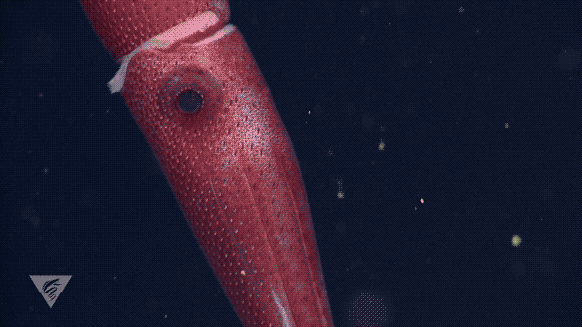Before the first deep-sea scientific trawls in the 19th century started revealing what lurks in the ocean depths, some scientists reckoned all the creatures down there were blind. It was so dark down there, went the logic, that the critters must use some other means to find their way around—perhaps a nice game of Marco Polo. But how wrong those scientists were (and that's OK, because being wrong is fine in science).
The deep is actually brimming with giant-eyed animals, which use their peepers to pick up what little light trickles down from the surface or to detect the bioluminescence of their own species—or their prey. In such a strange world, the eyes themselves get strange, and perhaps the weirdest among them belong to the strawberry squid. It has one normal eye and another enormous one that looks like it got stung by a bee. And these two eyes are looking for entirely different things: shadows and fireworks.
Now, you don’t earn the moniker of “strawberry squid” for not looking like a strawberry. “They have all these little strawberry seed dots all over them,” says Steve Haddock, a biologist at the Monterey Bay Aquarium Research Institute. “Those are all light-emitting photophores. Each has a lens and a filter to control the light output.”
A whole lot of creatures in the deep, including the strawberry squid, use something called counter-illumination as a defensive measure. The tiny bit of light that makes it into the depths can be hazardous—the squid’s predators can lie in wait below it, looking for its shadow against the light from above. But by lighting itself up with counter-illumination, the squid can in effect cancel out its shadow, helping it disappear.
Ironically, the strawberry squid hunts the same way, keeping its eye out for prey like fish and shrimp and other squid passing overhead. That’s eye—singular. Specifically, the giant one. “The hypothesis that's most accepted right now is the reason they have such a large eye and a small eye is that these eyes are looking at different types of light,” says Katie Thomas, a marine biologist at Duke University. “So the large eye is thought to orient upwards toward the surface and detect really dim sunlight that's trickling down through the water.”
The small one, by contrast, points downward to detect flashes of bioluminescence that could reveal prey. (While it would seem silly for creatures to be flashing so much and giving away their position to predators like the strawberry squid, bioluminescence is pivotal for individuals to communicate with other members of their species. Getting eaten ain’t great, but not getting laid is unacceptable.)
So, the big eye. It isn’t simply a scaling-up of the little one. It’s a different shape—semi-tubular, to be precise. Big lenses gather more light, but the bigger a lens gets, the farther it needs to be from the retina to be able to focus. By going tubular, the strawberry squid’s eyes gain that distance without the increase in volume a sphere would require. It’s a matter of efficiency. “They have a smaller field of view because their eye is narrower, but they gain sensitivity,” says Thomas.
(Tubular eyes are actually common. Take, for instance, the barreleye fish [some creatures just get lucky with their names], whose peepers are even more tubular than the strawberry squid’s. They’re encased in a sort of clear dome, pointing upwards to search for food, but the fish can also pivot them forward when it approaches its prey.)
The squid’s giant eye has another brilliant adaptation: a filter. In the video above you’ll see that the eye seems to glow yellow. “They have a pigment that looks yellow to us,” says Haddock, “but it's because it absorbs blue light preferentially to longer-wavelength light.” Say a fish's counter-illuminating belly hasn’t perfectly matched the color of the blue downwelling light. Perhaps it’s just a bit too green. The pigment in the squid’s lens will absorb the blue to make the green stand out that much more. “If there's any mismatch in the color of camouflaging light versus downwelling background light, it will enhance that difference.” It's a counter-defensive measure that can overcome the prey’s cloaking tactic.
It all adds up to one incredible organ, which may have you thinking: What gives with only developing one of them? Why should the eye that keeps watch on things below be so comparatively tiny, when it’s possible to develop a supercharged eye? Well, it may be because the giant eye is so powerful.
“Eyes are really expensive,” says Thomas. “Eyes are an expensive organ metabolically to make, they're expensive to maintain, they take a lot of neural processing power. So there’s definitely selection acting against huge eyes.” That is, natural selection would favor individuals whose eyes are great and all, but not so enormous that they’d be a drain on the organism’s energy and the resources needed to develop and maintain the things.
And keep in mind that each of the strawberry squid’s eyes has a different job. “If you're looking at something fairly bright like bioluminescent flashes and you don't need that extra boost of sensitivity, that could explain why the small eye isn't equally big,” says Thomas.
For my money, the strawberry squid’s eye is among the most brilliant manifestations of a...brilliant evolutionary manifestation. The eye, an extremely complex organ, is natural selection’s greatest triumph. Over millions of years, as organisms grew more complex from simple little sightless things, the eye evolved from uncomplicated eyespots to the wonder that is the strawberry squid's semi-tubular peeper.
So sure, the strawberry squid looks a bit lopsided, but it's an evolutionary triumph. It's hard to be perfectly symmetrical, after all. Well, except maybe for Denzel Washington. He's got a pretty good thing going.
Browse the full Absurd Creature of the Week archive here. Know of an animal you want me to write about? Are you a scientist studying a bizarre creature? Email matthew_simon@wired.com or ping me on Twitter at @mrMattSimon.

